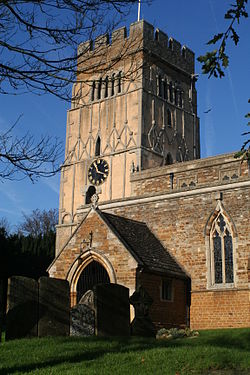All Saints' Church, Earls Barton
| All Saints' Church | |
|---|---|

Tower of All Saints parish church
|
|
| 52°15′57″N 0°45′12″W / 52.26583°N 0.75333°WCoordinates: 52°15′57″N 0°45′12″W / 52.26583°N 0.75333°W | |
| Location | Earls Barton, Northamptonshire |
| Country | England, UK |
| Denomination | Church of England |
| Churchmanship | Central |
| Website | www |
| History | |
| Dedication | All Saints |
| Architecture | |
| Status | Parish Church |
| Functional status | Active |
| Style | Anglo-Saxon |
| Years built | Late 10th Century |
| Administration | |
| Parish | Parish of Earls Barton |
| Archdeaconry | Archdeaconry of Northampton |
| Diocese | Diocese of Peterborough |
| Clergy | |
| Vicar(s) | The Revd Miranda Heyes |
| Laity | |
| Reader(s) | Simon Elvin |
| Churchwarden(s) | Iain Swift |
All Saints' Church, Earls Barton is a noted Anglo-Saxon Church of England parish church in Earls Barton, Northamptonshire. It is estimated that the building dates from the later tenth century, shortly after Danish raids on England.
The tower at Earls Barton was probably originally a tower nave, the ground floor serving as the main body of the church with a small chancel annexed to it to the east, as at St Peter's Church, Barton-upon-Humber, built at roughly the same period. A doorway on the south side of the tower, and originally another opening on the west face, allowed access to the outside. The upper floors possibly provided accommodation for the priest or acted as a safe-haven to house treasures, although it has been pointed out that such towers would have been deathtraps in a Viking raid, with their combustible wooden floors and multiple doors. There is a belfry at the uppermost storey.
The tower is constructed of stone rubble and rendered on the outside, and is decorated with vertical limestone pilaster strips and strapwork. At the corners of the tower, the walls are strengthened by long vertical quoin stones bedded on horizontal slabs, and hence is termed long and short work. The way in which the tower is decorated is unique to Anglo-Saxon architecture, and the decorated Anglo-Saxon tower itself is a phenomenon that occurs locally, including Barnack near Peterborough and Stowe Nine Churches in Northamptonshire.
The storeys are divided by projecting stone string courses, and at each successive storey, the walls become slightly thinner, creating a step at each string course. The vertical pilaster strips continue up the tower, and are interspersed with stone strip arches at lower level and triangular decoration at upper level, in some instances resulting in a criss-cross pattern.
...
Wikipedia
